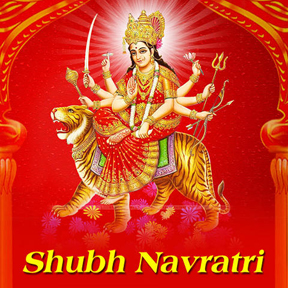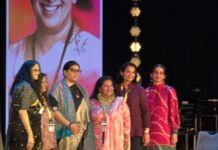
Navratri literally meaning “nine nights” is a multi-day Hindu festival celebrated in the autumn every year. It is observed for different reasons and celebrated differently in various parts of the Indian subcontinent. Theoretically, there are four seasonal Navratris. However, in practice, Sharad Navaratri in the bright half of the Hindu calendar month Ashvin, near autumn equinox (September-October) and Vasanta Navaratri in the bright half of the Hindu calendar month Chaitra near spring equinox (March-April) are most celebrated festivals.
The Sharada Navaratri ends on the 10th day as Vijayadashmi after the nine nights that celebrate good over evil. It is also called Dussehra. Vasanta Navratri ends on the 9th and final day which is celebrated as Ram Navami and Devi Vaishnavi celebration. These festivals are observed in the honor of the divine Devi Durga and Devi Vaishnavi respectively.
People need energy and willpower during seasonal changes. It is the time of the year to nurture and rejuvenate one’s body and mind through prayers, chants, meditation, fasting, and other spiritual practices, and coming out feeling refreshed, renewed and creative.
So, this is like conditioning the mind to a set pattern that is conducive to growth. The first three days are Tamasic, the next three days are Rajasic, and the last three days are Sattvic. In life, all these three qualities co-exist and we have to skillfully keep them under control.
During Navaratri, a pot is installed in a clean place in the home and a lamp is kept lighted at all times for the entire duration of the Navratri festival. This is called Ghatasthapana. To celebrate a good harvest and to propitiate the nine planets, women also plant nine different kinds of foodgrain seeds in small containers during these nine days and then offer the young saplings to the goddess.
Goddess Durga, the epitome of power or shakti, is worshipped during Navratri symbolizing victory of positivity over negativity. It is believed the goddess had nine forms and she is worshipped in these forms during the nine-night festival. These nine forms are:
1. Shailputri 2. Brahmacharini 3. Chandraghanta 4. Kushmanda 5. Skandmata
6. Katyayani 7. Kaalratri
8. Mahagauri 9. Siddhidatri
In both these Navaratris, it is said that without observing Kanya Pujan (done on the 8th day of the festival) the Sadhana or devotion to Maa Durga during Navratri is considered incomplete. In our Indian culture, woman is respected from her childhood -old age in her different roles. Ma Durga is the manifestation of feminine divinity and Kanya is symbolically seen as the purest form of Ma Durga.
A young girl goes on to take the role of Ma Parvati as a wife and a mother; Ma Lakshmi when she takes charge of her household; Ma Annapurna when she feeds her family; Ma Saraswati when she rears her children and imparts knowledge; and finally, as Ma Durga when she eradicates all the problems surrounding her family and loved ones.
Many believe that the universe was actually created by Ma Durga, the Mother Goddess. She is supreme to all the male gods. They are incomplete without Devi Shakti (power). Brahma’s creation is incomplete without the Goddess of knowledge, art and music (Saraswati), Vishnu’s caring for is incomplete without the Goddess of Wealth and Prosperity (Lakshmi), and Shiva’s destruction of evil and transformation is incomplete without Goddess Durga.
In Indian Society, like cosmic mother, even our biological mothers are worshipped as ‘Matru Devobhava.’ Those who do not honor their mothers, do not obtain the blessing of Mother Goddess. So, offer special prayers to Maa Durga who protects all her devotees from evils, bestowing them with knowledge and prosperity. Hinduism is the only religion in the world which has emphasized motherhood to such an extent.
In northern parts of India, Rama’s victory over Ravana is celebrated during this time. The ten days represent the ten heads of Ravana, and each day is used by Hindus to get rid of bad characteristics, such as lust and jealousy. The tenth day is known as the Day of Victory.
In West Bengal, Durga puja is celebrated on a massive scale. Massive idols of Goddess Durga are installed and huge pandals are set up at various places for devotees to visit and worship. Everyone attends in new clothes.
In South India, idols of various gods and goddesses are placed on specially set-up steps. This arrangement is called Golu. The royal deity of Mysore, Chamundi is worshipped on this day and taken out on decorated elephants in a procession. The streets are colorfully decorated. Computers, books, vehicles, kitchen tools are worshipped on the 9th day.
In Gujarat, the feminine form of Divinity that is the Goddess Durga, represented by Garbha Deep – a small lighted earthen lamp in a painted pot having small wholes all around. The word Garba comes from the Sanskrit word for womb and so implies gestation or pregnancy – life. The vessel itself is a symbol of the body, within whom Divinity (in the form of the Goddess) resides.
Garba is danced around this symbol to honor the fact that all humans have the Divine energy of Devi within them. The dance’s circular patterns represent the movement of time and the cycle of life from birth to death to rebirth again. Another interpretation of Garbha is that it represents “Tamaso m? jyotir gamaya” means “From darkness, lead me to light” by getting rid of egoism.
I cordially invite all the devotees of Lake County to participate and obtain the blessings of Maa Durga as her nine manifestations will be worshiped on each day of Navratri at the Hindu Mandir of Lake County, Grayslake, IL.
Pt Anil Joshi, Grays Lake Hindu Temple






